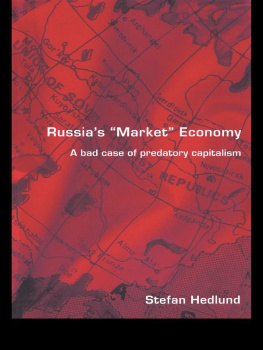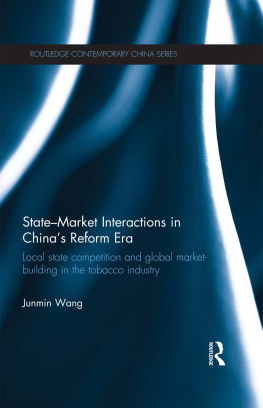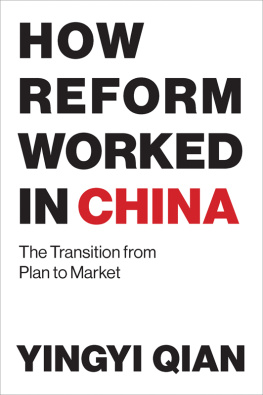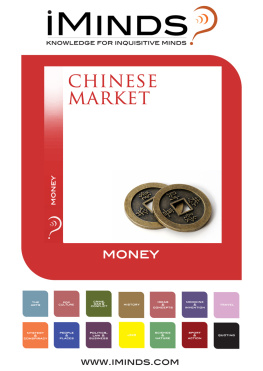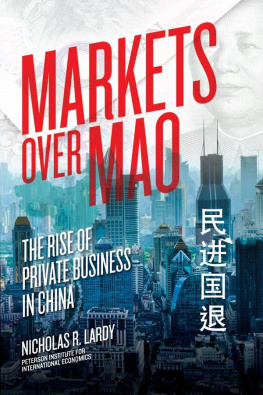The Chinese Market Economy
The Chinese Market Economy
10001500
William Guanglin Liu
Cover image is from Wikimedia Commons and is a detail of the Chinese cityscape handscroll Along the River During Qingming Festival , ink and colors on silk, 25.5 525 cm.
Published by State University of New York Press, Albany
2015 State University of New York
All rights reserved
Printed in the United States of America
No part of this book may be used or reproduced in any manner whatsoever without written permission. No part of this book may be stored in a retrieval system or transmitted in any form or by any means including electronic, electrostatic, magnetic tape, mechanical, photocopying, recording, or otherwise without the prior permission in writing of the publisher.
For information, contact State University of New York Press, Albany, NY
www.sunypress.edu
Production, Diane Ganeles
Marketing, Fran Keneston
Library of Congress Cataloging-in-Publication Data
Liu, William Guanglin.
The Chinese market economy, 10001500 / William Guanglin Liu.
pages cm
Includes bibliographical references and index.
ISBN 978-1-4384-5567-9 (hardcover : alk. paper)
1. ChinaEconomic conditionsTo 1644. 2. ChinaEconomic policyTo 1644. 3. ChinaCommerceHistoryTo 1500. I. Title.
HC427.6.L5828 2015
330.95102dc23 2014017092
10 9 8 7 6 5 4 3 2 1
Illustrations
Maps
| Map 1. | Water routes and long-distance trade in Song China, ca. 1077 AD |
| Map 2. | Water routes and long-distance trade in late sixteenth-century China |
Figures
Tables
Acknowledgments
This book is dedicated to Professor Dwight H. Perkins. Although I alone am responsible for the analysis in the text, I could not have undertaken this study without his mentorship at Harvard. Dwight encouraged and supervised my Ph.D. thesis writing when I attempted to exploit certain historical data I found from the extant sources. Needless to say, his research on Chinese economic history, especially his work on Chinese agricultural development from 1368 on, laid the very foundation of my current project.
I benefited from the help of many individuals and institutes and it is a pleasure to have this opportunity to express my appreciation. My gratitude first goes to Professor Peter K. Bol, who is the most inspiring teacher I have met, and Professors Philip Kuhn, Jeffrey Williamson and other faculty members at Harvard graduate school. I am also grateful to the Harvard-Yenching Institute for supporting my graduate study, and to the Harvard-Yenching Library for allowing me a wonderful research experience. In preparing this book, I have benefited throughout these years from discussions and associations with many teachers, friends, and colleagues. I cannot adequately acknowledge the valuable suggestions and comments on my written work and presentations that have been given so generously by so many scholars over the past decade. In particular I would like to thank Professor Peter Lindert, Philip Hoffman, Patrick K. OBrien, Kevin ORouke, Charles Hartman, Peter Perdue, Kenneth Pomeranz, Richard von Glahn, Ma Keyao, Cao Shuji, Wu Songdi, Liang Keng-yao, Bozhong Li, James C. Lee, James Kung. The National Science Foundation and NBER provided a grant for the collection of raw data that was crucial in developing this project. I shall thank the HKUST, my home institute, and the Research Grant Committee of Hong Kong for their generous support that allowed me to spend time in Boston conducting research to finalize my manuscript. I am also indebted to Chen Zhang and Anne NG, who patiently read through the manuscript to give invaluable editing advices. Nancy Ellegate and Diane Ganeles at the SUNY Press guided me through the whole review, editorial and publication process.
Finally, my deepest debt of thanks goes to my wife Hanrui Wang. This book could not have been conceived or completed without her constant loving support.
W. G. L.
Dynasties, Events, and Equivalents
I. Dynasties and Events
The Chinese Dynasties
Tang (618907)
Song (9601279):
Northern Song (9601127)
Southern Song (11271279)
Yuan, the rule of Mongols in China (12711368)
Ming (13681644)
Early Ming (13681450)
Qing (16441911)
The An-Lushan Rebellion (755763)
The Mongol Conquest of China (12111276)
II. Weights and Capacity
Weights: picul ( dan ) is a unit of weight equal to 100 catties ( jin ) or 50 kg.
1 picul ( dan ) = 100 catties ( jin ) = 50 kg
1 catty ( jin ) = 16 taels ( liang ) = 500 g = 1.1 pounds
20 picul ( dan ) = 1 metric ton
2,000 catties = 1 metric ton
1 Tang jin = 670 g
1 Song jin = 640 g
1 Yuan jin = 620 g
1 Ming jin = 590 g
1 Qing jin = 590 g
1 tael ( liang ) = 10 qian () = 100 fen () = 37.3 g
1 Song tael = 40 g
1 Ming tael = 36.9 g
1 Qing tael = 37.3 g
Volumes:
Grain
Shi () is the basic unit of traditional Chinese volume measurement for grain: 1 shi equals 100 liters; 1 shi of husked rice usually weighs 150 catties ( jin ), 75 kg., or 1.5 piculs; 1 shi of wheat equals 140 catties ( jin ) or 70 kg.
1 shi () = 100 liters = 22 English gallons
1 shi () = 10 dou () = 100 sheng ()
1 sheng = 1 liter
1 Song shi = 0.67 shi = 67 liters
1 Yuan shi = 0.95 shi = 95 liters
1 Ming shi = 1.0 shi = 100 liters
1 Qing shi = 1.0 shi = 100 liters
Textiles: for handmade cotton cloth, 1 bolt ( pi ) is the basic unit.
1 bolt = 3.63 square yards
1 bolt of cotton cloth weights 0.375 pounds
Li () is the basic unit of traditional Chinese measurement for distance.
1 li = 0.3107 mile
1 Sui li = 415 meters
1 Tang li = 450 meters
1 Song li = 465 meters
1 Ming li = 510 meters
1 Qing li = 510 meters
Mu () is the basic unit of traditional Chinese land measurement.
1 mu = 0.1647 acre
1 qing () = 100 mu = 16.4737 acres
1 Song mu = 0.1399 acre
1 Yuan mu = 0.1399 acre
1 Ming mu = 0.1434 acre
1 Qing mu = 0.1518 acre
III. Units of Currencies
Silver :
Tael ( liang ) is the basic unit of traditional Chinese silver measurement: 1 tael of silver is about 37.68 g of silver.
1 tael of silver = 37.68 g of silver
1 metric ton of silver = 26,000 taels of silver
100,000 taels of silver = 3.846 metric ton of silver
1 Song tael of silver = 40 g
1 Ming tael of silver = 36.9 g
Coin:
Wen () is the smallest unit of traditional Chinese coins: Usually 1 bronze coin is worth 1 wen ; 1,000 wen equals 1 string of cash (1 or 1 ). In the Song, 1 string of cash often contained fewer coins but was rated as equivalent to a full string of 1,000 coins due to severe shortages of coin. The Song government established the official short string ( shengbo ) at 770 coins per string of cash.


